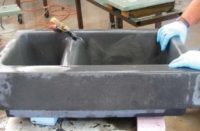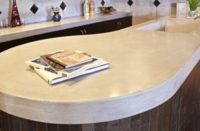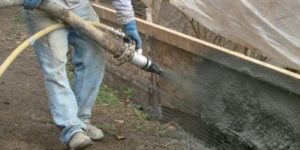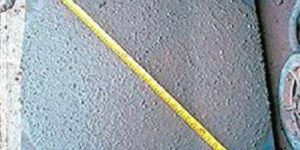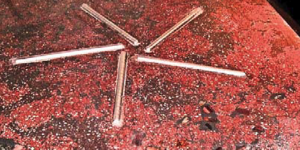Self-consolidating concrete is a highly technical mix. It is not an easy mix to create, since it requires an understanding of how all the ingredients work together. What’s more, specialized testing is required to characterize and optimize the mix.
Self-consolidating concrete starts with ordinary concrete ingredients, but the mixing process and proportions are different. In a 2003 paper for the Japan Concrete Institute (JCI), Hajime Okamura and Masahiro Ouchi outlined a rational mix design methodology and suggested test methods for producing SCC. Here’s a brief summary of their starting mix design proportions:
- Coarse aggregate content is fixed at 50 percent of the total solid volume.
- Fine aggregate content is fixed at 40 percent of the mortar volume.
- Water-to-powder ratio (by volume) is assumed to be 0.9 to 1.0 depending upon the properties of the powder (which can be cement, pozzolan or powdered stone).
- The final water-to-powder ratio and superplasticizer dosage are determined so as to ensure self-compactibility.
The basic makeup of SCC varies around the world and there are many different models for creating an SCC mix design besides the JCI model. In general:
- The largest aggregate sizes in SCC range from 3/4 inch to 1 inch in diameter.
- Powder can consist of portland cement, a blend of portland cement and a pozzolan, or portland cement and powdered limestone (or another stone).
- The pozzolan can be fly ash, metakaolin, silica fume or slag, and the makeup of the powder could include some combination of the aforementioned materials.
What is important to realize is that these guidelines are a starting point. Variations or changes in ingredients, such as changes in aggregate gradation or cement fineness, will have a profound influence on the mix and whether it achieves the required characteristics. Designing an SCC mix is a repetitive process that starts with these basic proportions but alters them again and again based on how each newly created mix behaves. Individual mix designs based on local ingredients will most likely differ from the JCI guidelines. When SCC first came out, there were different styles or approaches in Europe, Japan and America.
Two essential admixtures
Two very important admixtures to understand when working with SCC are an advanced, powerful superplasticizer and a segregation-controlling viscosity modifier (VMA), which is sometimes used in combination with ultrafine powders to control viscosity.
Conventional superplasticizers (melamine, naphthalene and lignosulfonate types) function mainly through electrostatic repulsion. In a very simplistic way, they act a lot like dryer sheets, but instead of eliminating static cling (so your socks don’t stick together), the superplasticizers cause the cement particles to repel each other. The superplasticizer gives the cement particles an overall negative charge. Since like charges repel each other, the more negatively charged the cement particles are, the greater they repel each other and the more powerfully the superplasticizer performs.
The superplasticizer used to make SCC is a polycarboxylic ether, which is an advanced third-generation superplasticizer. Polycarboxylate superplasticizers use electrosteric repulsion, which is a combination of electrostatic and steric repulsion. Steric repulsion is generated by polymeric “fingers” that are attracted to the cement particles and provide extra particle separation and mobility. It’s this combination that makes polycarboxylate-based superplasticizers so powerful and effective. These new superplasticizers are not only more powerful than other types of superplasticizers, their effects last longer too.
The other admixture commonly used in SCC alongside polycarboxylate superplasticizers is a viscosity modifier. Viscosity-modifying admixtures (VMA) thicken the cement paste, increasing its viscosity. Essentially, the VMA makes the runny cement paste thick enough that the aggregates remain suspended and don’t settle out.
Not all SCC mixes use or need a viscosity modifier. But using one can add an extra degree of segregation control to respond to unforeseen aggregate moisture, changes in the fine aggregate content or other factors that affect the concrete’s viscosity.
The importance of testing
Central to the development of an SCC mix design for each project is testing. An SCC mixture should be designed and tested in the lab and in a production setting to verify its performance prior to use on a job. Unlike conventional concrete, where one basic test is needed for assessing workability (slump), SCC requires several specialized tests. The tests are used to gauge the mix’s flowability and its viscosity. Some tests also assess the ability of the mix to pass between congested rebar.
These tests include:
- A modified form of the SCC slump test (ASTM C1611) and a J-ring test of the passing ability of SCC (ASTM C1621).
- Viscosity is assessed several ways, including the visual stability index (VSI), taken at the end of the C1611 test. The column technique (ASTM C1610) assesses static segregation.
- Other tests include the L-box, the U-box and the V-funnel. These three tests are not formally standardized but are useful laboratory tools for developing and refining a specific SCC mix.
When concrete countertop manufacturers make their own in-house concrete using this information, the concrete they make may not be strictly defined as SCC, but the overall characteristics of greater flowability and segregation resistance may prove adequate for their needs.
For construction applications where congested rebar or the need to reduce labor costs make SCC the concrete of choice, it’s vital that special care be exercised by all parties in design and implementation, since the project needs justify and demand the properties that SCC provides.
